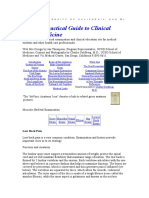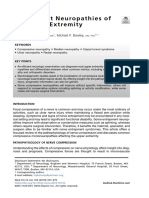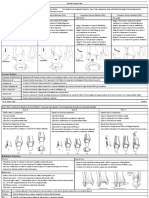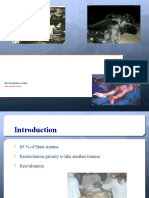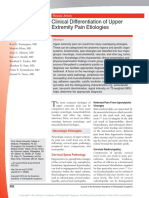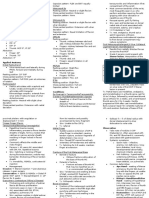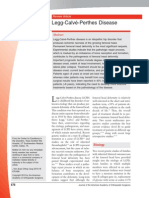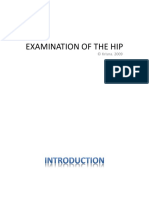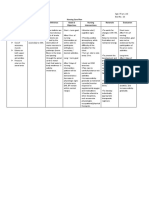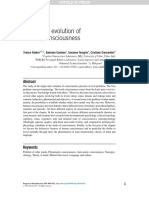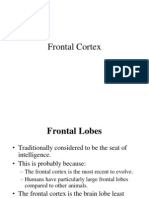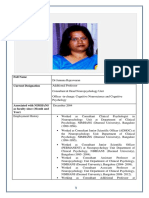Spine PDF
Spine PDF
Uploaded by
DRAHMEDFAHMYORTHOCLINICCopyright:
Available Formats
Spine PDF
Spine PDF
Uploaded by
DRAHMEDFAHMYORTHOCLINICOriginal Title
Copyright
Available Formats
Share this document
Did you find this document useful?
Is this content inappropriate?
Copyright:
Available Formats
Spine PDF
Spine PDF
Uploaded by
DRAHMEDFAHMYORTHOCLINICCopyright:
Available Formats
Lumbar Disc Prolapse (Herniation)
Definition: Acute disc herniation that produce Neurologic compressive disorders & pain Pathology:
Epidemiology:
- The condition occurs due to:
- 95% involve L4,5 or L5,S1 levels (L5,S1 most common level) a. Physical stress: Combination of flexion + Compression (Mainly on L4,5 or L5,1)
- only 5% become symptomatic b. Disturbance of hydrophilic properties of í nucleus
- ♂:♀ = 3:1 - At first: there is posterior bulge of í disc éout rupture
- Mostly in 4th & 5th decades (Very young & very old seldom have acute LDP) - Eventually í annulus will rupture usually postero-lateral, but it may occur central
- In adolescents look for Infection, Benign tumors & Spondylolisthesis - Neurological manifestation occur due to:
- In í elderly look for vertebral compression # & Malignancy 1. Compression of í roots of í level below é posterolateral bulge (90%)
2. Compression of í root of í same vertebra above é far lateral bulge
Pathoanatomy: 3. Compression of í multiple roots centrally (Cauda Equina) é central bulge
4. Compression of í cord (Conus Medullaris) é central bulge at D12,L1
- Recurrent torsional strain leads to tears of í Annulus fibrosis ώ leads to herniation of Nucleus pulposis
Classification:
Location Classification: Anatomic Classification:
- Often associated é back pain only
Central: Protrusion: - Eccentric bulging é an intact annulus
- May present é Cauda Equina syndrome ώ is a surgical emergency
Posterolateral - Most common (90-95%)
Extrusion: - Disc material herniates through annulus but remains continuous é í disc space
(Paracentral): - Affects í traversing, descending & lower nerve roots (L4,5 affects L5 nerve root)
Foraminal - Less common (5-10%)
Sequestration: - Disc material herniates through annulus & is no longer continuous é í disc space
(Far lateral): - Affects exiting & upper nerve roots (L4,5 affects L4 nerve root)
Axillary: - Can affect both exiting & descending nerve roots
Radiology: (Mainly Clinical Dx) DDx: Red Flags for Back Pain:
1. PXR: 1. Inflammatory disorders 1. Trauma
- Narrow disc space - Infection, Ankylosing Spondylitis 2. Unexplained weight loss
- Traction spur - Causes ↑ S ffness, ↑ ESR & Erosive PXR 3. Neurologic symptoms
- Facetal arthropathy 2. Vertebral tumors 4. Age > 50 yrs
- Straightening of í spine (Ms spasm) - Osteoid osteoma, Osteoblastoma 5. Fever
2. CT: More accurate & reliable - Causes Severe pain é Marked spasm 6. Inability to find a comfortable position
3. MRI: Study of choice 3. Nerve tumors 7. Steroid use
- Assess í cord & root condition - Neurofibromata of Cauda equina 8. History of malignancy (Prostatic, Renal, Breast, Lung)
- Confirm í disc; its size & extent - Causes Sciatica é continuous pain
4. Myelography: Limited value after MRI
Dr. A. Samy TAG Lumbar Diseases | 1
C/P:
Symptoms: Physical exam:
Standing: (Postural changes)
1. Sudden Severe backache é lifting a heavy object followed by inability to straighten up 1. Inspection:
2. Scitica: Few days later symptoms of nerve irritation appear more to one side: - Sciatica List (Scoliosis): Ptn bend to one side due to muscle spasm
- Referred to buttocks, back of thigh & leg more to one side - ↑ é cough & strain - Lumbar lordosis: due to muscle spasm
3. Radiculopathy: Few days later symptoms of nerve compression appear more to one side: - Flexed Knee: ptn bend it to ↓ tension on í sciatic nerve
- Sensory symptoms (hyposthesia or parasthesia) & Motor weakness 2. Palpation: Back tenderness max on lower vertebrae
4. Cauda Equina manifestation: If central compression occur 3. Movements: Limited all back movements
- Bilateral LMN weakness in í legs - Schober test: Mark 4 points in posterior midline & ask í ptn to bend & straight up & measure í difference.
- Bilateral Sciatica
- Loss of perianal sensation "Saddle anathesia"
Supine: (Stretch signs)
- Urinary incontinence (Insensinate UB, painless retention é overflow)
1. Straight leg raise (SLR): Raising í leg at 30°-70° hip flexion reproduces pain & paresthesia at buttocks & calf
- Fecal incontinence
(rather than thigh & back)
5. Conus Medullaris manifestation: If central compression occurs at a higher level D12,L1:
2. Lesegue sign: SLR aggravated by forced ankle dorsiflexion
- Not common
3. Crossed SLR: Less sensitive but more specific
- Bilateral LMN weakness at L1
4. Bowstring sign: SLR aggravated by compression on lateral popliteal nerve
- Bilateral UMN weakness below
5. Brudzinski test: While í hip & knee extended; Pain is reproduced é passive neck flexion
- Urinary incontinence (Insensinate UB, painless retention é overflow)
6. Kernig test: While í hip & knee flexed; Pain is reproduced é passive leg extension
- Fecal incontinence
7. Naffziger test: Pain reproduced é coughing ώ is triggered by applying pressure on í ptn neck veins
6. Warnings:
8. Milgram test: Pain reproduced é straight leg elevation for 30 seconds in í supine position
- Sciatica is a referred pain to prolapse. It can also come from facet, SI joints or infection
9. Hoover test for malingerer:
- Maximum 2 levels; if multiple levels suspect neurological cause
- é í ptn supine hold both heels & ask í ptn to do active SLR on í affected side
- Severe, Unrelenting pain is not a feature of disc prolapse; suspect tumor or infection
- Pressure should be noted in í opposite heel (Attempt to stabilize for movement)
Natural History:
If absent pressure or inability to do SLR í ptn is malingerer
- After:
- 1st episode: 90% improve & do not relapse
- 2nd episode: 90% improve & 50% relapse
Neurological impairment: L4,5 compress on L5 & S1 nerve roots
- 3rd episode: 90% improve & 100% relapse
- Regardless of treatment, impaired motor function had a good prognosis whereas sensory - L5 impairment: Motor weakness of Knee flexion & Big toe extension - Sensory symptoms on outer leg &
deficits remained in almost 50% of all patients. dorsum foot - Normal knee & ankle reflexes
- S1 impairment: Motor weakness of planter flexion & eversion of í foot - Sensory symptoms on outer foot &
dorsum little toe - Depressed ankle jerk
Straight leg raise Lesegue sign Bowstring sign Brudzinski test Kernig test
Dr. A. Samy TAG Lumbar Diseases | 2
Treatment:
Non-operative: 90% effective (Majority Of LDP require no surgical intervention) Operative:
1. Bed rest in Fowler position é knee flexed ± Traction for 2wks Indication:
2. NSAIDs 1. Cauda Equina syndrome is considered an emergency
3. Pelvic corset 2. Persistent leg pain despite adequate conservative measures > 3 wks
4. Physiotherapy: Back classes helpful - Wt reduction - Work modification 3. Neurological Deterioration in spite of conservative ttt
5. Epidural injections of Local anesthesia ± Steroid 80-120mg Depo-medrol
6. If all failed chemonucleolysis by chemopapain (Dangerous & less effective than surgery)
Standard Operative treatment: Persistent pain after surgery:
1. Disc prolapse at another level
1. Standard Laminectomy 5. Percutaneous Suction Discectomy (Automated Percutaneous Lumbar Discectomy) APLD:
2. Late due to post-lamenectomy Instability
2. Inter-Laminar Discectomy: for Central discs - Rotatory Shaver probe is inserted into í disc under PXR guidance
(Never remove >1/3 í facet)
3. Inter-Transverse Discectomy: for Far foraminal discs - The probe cut í disc & then sucked via í same probe
3. Root compression due to: Facetal OA, Narrow
4. Micro-Discectomy: under microscopic magnification 6. Percutaneous Laser Discectomy using í YAG or KTP laser beem
lateral recess
- Shorter stay, mini incision 7. Percutaneous Endoscopic Discectomy:
4. Residual disc material
- Need experience + intra-operative PXR - Series of dilators are introduced to í bone followed by insertion of wide cannula
- More complication (Bleeding, infection, limited field) - Special endoscopic instruments are used to retract, cut & excise í disc
- Dural tear: headache + soaked wound é brown halo 8. Percutaneous Disc Radio-Ablation:
- +ve β2 transferin - Evaporization of í Nucleus Pulposus using í radiofrequency
- Small: nothing to be done (bed rest) - Excellent treatment for eradicating leg pain but not for back pain
- Medium: interrupted water tight sutures - The addition of spinal fusion at í same time as discectomy has not been proven to be superior to
- Large: autogenous fat graft or gel foam or adcon-L simple discectomy & adds considerable morbidity
9. Disc Replacement Surgery (Disc Prosthesis):
Types: Rational for Disc Prosthesis: Advantages:
1. Screw fixation 1. Replace í degenerative painful disc by a mechanically sound prosthesis 1. The device maintain í proper intervertebral spacing
2. Staple fixation 2. It restores í height 2. Provide stability
3. Teeth fixation 3. It restores í motion 3. Restore í normal shock absorbing mechanism of í spine
4. Porous coated prosthesis 4. Regain í physiologic stiffness in all planes of motion plus axial compression 4. Less morbidity than í standard fusion techniques
5. Macrotexture surface prosthesis 5. Withstand í physiologic stress & transmit it to í next level 5. Better functional outcome
6. Hydrogel prostheses: replace í NP only & retain í AF 6. It could be done Percutaneous é nuclear hyrdogel replacement
Indications: Contraindications: Precautions:
1. Degenerative Disc Disease at í L4,L5 or L5,S1 level 1. Previous back surgery (except discectomy, laminotomy or nucleolysis) 1. Should be place centrally not to shift axial load to í facets
2. At least 6 months of conservative treatment 2. Multiple level degeneration, ligamentous laxity, Spondylolisthesis or Scoliosis 2. Avoid í destruction of facets & ligaments
3. Still under trial for cervical & thoracic prolapse 3. Facetal pain 3. An artificial disc must exhibit tremendous endurance
4. Morbid obesity
5. Osteoporosis, Steroids, Metabolic bone dse or autoimmune disorder
Complications:
- Biomechanical complications: - Surgical complications: - Biological complications:
1. Bone resorption 1. Neurological complications 1. Abnormal bone deposition
2. End plate failure 2. Vascular complications 2. Infections
3. Prosthesis failure 3. Visceral complications
4. Facetal over load & degeneration
Dr. A. Samy TAG Lumbar Diseases | 3
Spinal Stenosis
Definition: Symptomatic Narrowing of í spinal canal at its central, lateral recess or lateral foramen.
Epidemiology: Classification:
- L4/5 segment is í most commonly affected, followed by L3/4. Etiologic Classification: (Arnoldi Classification) Anatomic Classification:
- 60th & 7th decade of life
1. Congenital Vertebral Dysplasia: 1. Central stenosis:
- ♂ > ♀ narrower canals at L3/5 levels.
- Short pedicles é medially placed facets (Achondroplasia - <10mm A-P diameter on axial CT
- Diameters are measured by:
or Hypochondroplasia) - Thecal sac compressed
- Mid-sagittal (AP): 20 mm 2. Acquired: - Presents é nonspecific root compression or symptoms of lower nerve root
- Interpedicular (Transverce): 11.5 mm 1. Degenerative/Spondylotic (Most common) (at L4/5 level í root of L5 affected)
- Causes of canal stenosis: 2. Post surgical (Iatrogenic) 2. Lateral recess stenosis:
- Bony structures: - Soft tissue structures: 3. Traumatic (Vertebral fractures) - Associated é facet joint arthropathy & osteophyte formation
- Facet osteophytes - Synovial facet cysts 4. Inflammatory (Ankylosing spondylitis) - Presents é symptoms of lower nerve root (at L4/5 level í root of L5 affected)
- Uncinate spur - Herniated or bulging discs 5. Infection 3. Foraminal stenosis:
- Spondylolisthesis - Hypertrophy or buckling of í 6. Tumor - 2ry to disc protrusion, Osteophytes, Disc collapse
ligamentum flavum 7. Metabolic & Endocrinal - Present é symptoms of higher nerve root(at L4/5 level í root of L4 affected)
C/P: Imaging: Complications:
Symptoms: 1. Standing AP & lateral: may show Complications ↑ é age, blood loss & levels fused
1. Back pain 1. Nonspecific degenerative findings (↓ Disk space, Osteophytes) Major complication
2. Referred buttock pain 2. Degenerative scoliosis 1. Wound infection (10%): Deep surgical
3. Leg pain (often unilateral) 3. Degenerative spondylolisthesis infections are to be treated é surgical
- Pain worse é extension (Walking downhill, standing upright) 2. Flexion/extension views: Segmental instability & subtle degenerative debridement & irrigation
- Pain relieved é flexion (Walking uphill, sitting, squatting, leaning) spondylolisthesis 2. Pneumonia (5%)
4. Neurologic Claudication 3. MRI: Gold standard, Findings include: 3. Renal failure (5%)
5. Weakness, Heaviness, Numbness, Parathesia in í thigh & legs 1. Central stenosis é a thecal sac < 100mm2 4. Neurologic deficits (2%)
6. Bladder disturbances: UTI (10%) due to autonomic sphincter dysfunction 2. Obliteration of perineural fat & compression of lateral recess or foramen Minor complication:
7. Cauda Equina syndrome (rare) 3. Facet & ligamentum hypertrophy 1. UTI (34%)
Physical Exam: 4. CT myelogram: More invasive, Findings include: 2. Anemia requiring transfusion (27%)
1. Reproduction of symptoms by walking 1. Provides dynamic information (Degree of cut off é extension) 3. Confusion (27%)
2. Kemp sign: Unilateral radicular pain from foraminal stenosis made worse 2. Central & lateral neural element compression 4. Dural tear
by extension of back 3. Bony anomalies 5. Failure for symptoms to improve
3. Straight leg raise (Tension sign): Usually negative 4. Bony facet hypertrophy
4. Valsalva test: Radicular pain not worsened by Valsalva as in case of LDP
Treatment:
Nonoperative: 1st line of treatment in Mild to Moderate cases Operative: Large laminectomy é flavectomy, Medial facectomy & Discectomy
1. NSAIDS & Muscle relaxant 1. Wide pedicle-to-pedicle decompression: 2. Wide pedicle-to-pedicle decompression é instrumented fusion:
2. Weight loss Indications: Indications:
3. Bracing 1. Persistent pain for 3-6 months that has failed to improve é 1. Presence of segmental instability (isthmic spondylolisthesis,
4. Physical therapy nonoperative management degenerative spondylolisthesis, degenerative scoliosis)
5. Steroid injections (epidural & transforaminal) effective & may 2. Progressive neurologic deficit 2. Surgical instability created by complete laminectomy and/or
obviate need for surgery 3. Impaired daily activity removal of > 50% of facets
Dr. A. Samy TAG Lumbar Diseases | 4
Spondylolisthesis
Definition: Mechanism:
- Forward translation of one segment of í spine upon another. - Causes of spondylolisthesis are multifactorial but a large proportion are degenerative.
- í shift is nearly always at L4/5 (11%), or at L5/S1 (82%). - It occurs only when í normal locking mechanism that prevents each vertebra from moving forwards on í one below has failed.
Classification:
Wiltse-Newman Classification: Most commonly used. Myerding Classification: Based on % of í slippage
Type I Dysplastic: - It includes congenital abnormalities of í lumbosacral junction Grade I - < 25%
A - Disruption of pars as a result of stress # (More common) Grade II - 25 to 50%
Type II Isthmic (Lytic): B - Repeated healed microfractures cause elongation of pars éout disruption Grade III - 50 to 75%
C - Acute Pars # Grade IV - 75 to 100%
Type III Degenerative: - Facet instability éout pars # due to degenerative changes in í disc & facet joint Grade V - Spondyloptosis (all í way off)
Type IV Traumatic: - Acute posterior arch # other than í pars N.B.: Grade III & greater are rare in degenerative
Type V Pathologic: - Pathologic destruction of í pars due to tuberculosis or neoplasm spondylolithesis
Type VI Iatrogenic: - It is not part of í original classification but é injudicious facetectomy & pars # during laminectomies, iatrogenic instability can occur.
Wiltse-Newman Classification: Most commonly used.
Type I : Dysplastic Type II : Isthmic (Lytic) Type III : Degenerative
- It includes congenital abnormalities of í
- Facet instability éout pars # due to
lumbosacral junction: í superior sacral - Defects in í pars interarticularis (Spondylolysis) or repeated
degenerative changes in í disc & facet joint
facets are deficient or malorientated & í breaking & healing may lead to elongation of í pars.
- It is nearly always at L4/5 & mainly in women
sacrum is dome-shaped or hypoplastic. í - It present in childhood & adolescence & often runs in families
of middle age
pars may be poorly developed. - It has a benign course & does not change é increasing age from 20
- It is commonly seen above a sacralized L5
- It present in childhood & adolescence. to 80 years & í majority of cases are asymptomatic. Only 4%
vertebra due to increased mechanical
- Slow & relentless forward slip leads to progress to significant slips of > 20% over several years.
stresses.
severe displacement.
- They rarely progress > 30% of í body width.
- Associated anomalies (Spina bifida occulta) are common.
Type II A: Type II B: Type II C:
- Disruption of pars as a result of stress #
- Repeated healed microfractures cause
from repetitive loading especially in
elongation of pars éout disruption
competitive athletes (Commonest variety) - Acute Pars #
- It is occasionally confused é dysplastic
- This results in a radiolucent defect in í
type.
pars (non-union).
Type IV : Traumatic Type V : Pathologic Type VI : Iatrogenic
- It is not part of í original classification but é
- Acute posterior arch # other than í pars
- Pathologic destruction of í pars due to injudicious facetectomy & pars # during
result in destabilization of í lumbar spine
tuberculosis or neoplasm laminectomies, iatrogenic instability can
& allow vertebral slip.
occur.
Dr. A. Samy TAG Lumbar Diseases | 5
Pathology:
- They will progress in 32% of cases. They are more likely to become high-grade slips é significant neurological injury & more commonly require surgery.
- Anterior vertebral translation results in a sagittal deformity é compensatory pelvic rotation. This results in a vertical sacrum & loss of lumbar lordosis.
Type I
- é forward slipping there is compression on í cauda equina & í exiting foraminal nerve roots (L5).
- í degree of slip is measured by í amount of overlap of vertebral bodies & is expressed as a percentage. High-grade slips have >50% translation.
- Healing can occur é immobilization especially é unilateral defects.
Type II - When non-union occurs, í # becomes corticalized & filled é fibrous tissue & A lytic defect is visible on X-ray.
- í loss of í posterior facet support results in increased disc loads é subsequent degeneration & a small risk of spondylolisthesis (4%).
- It is characterized by segmental instability due to disc or facet incompetence é osteophytes & facet effusions.
Type III - Lateral recess stenosis occurs due to facet osteophytes & ligamentum flavum hypertrophy ώ encroaches on í traversing nerve roots.
- Occasionally there is foraminal stenosis ώ compresses í exiting nerve root.
Clinical Picture:
Symptoms: Physical exam:
1. Typical flat buttocks, “heart-shaped buttocks” of high-grade spondylolisthesis
Typically a child or adolescent presents é: 2. Vertically oriented sacrum
1. Mechanical low back pain: Most common presentation 3. A palpable lumbosacral step.
- Usually relieved é rest & sitting 4. Hamstring tightness is common & may result in flexed hips & knees
- It may radiates to í buttock or posterior thighs. (Must differentiated from neurogenic leg pain).
- Onset is usually insidious & related to sporting activities 5. Neurological examination may reveal nerve root tension signs:
- Occasionally an acute injury may precipitate events. a. L4 nerve root involvement (Compressed in foramen é L4/5 DS):
2. Neurogenic Claudication & leg pain: 2nd most common presentation - Weakness to quadriceps: best seen é sit to stand exam maneuver
- Defined as buttock & leg pain or discomfort caused by upright walking - Weakness to ankle dorsiflexion (Cross over é L5): best seen é heel-walk exam maneuver
- Relieved by sitting - Decreased patellar reflex
- Not relieved by standing in one place (as is vascular Claudication) b. L5 nerve root involvement:
- May be unilateral or bilateral - Weakness to ankle dorsiflexion (Cross over é L4): best seen é heel-walk exam maneuver
- Same symptoms found é spinal stenosis - Weakness to EHL (Great toe extension)
3. Neurological deficit & Cauda Equina syndrome are rare. - Weakness to Gluteus medius (Hip abduction)
4. In Degenerative spondylolisthesis: Middle age ptn presents é: 6. Provocative walking test:
- Chronic lower back pain - Have ptn walk prolonged distance until onset of buttock & leg pain
- Spinal stenosis or radicular pain. - Have ptn stop but remain standing upright: if pain resolves this is consistent é vascular claudication
- Walking distance is restricted - Have patient sit: if pain resolves this is consistent é neurogenic claudication (DS)
- Symptoms are relieved by forward flexion.
Prognosis:
- Dysplastic spondylolisthesis appears at an early age, often goes on to a severe slip & carries a significant risk of neurological complications. If progression is predicted, early surgery is recommended.
- Lytic (isthmic) spondylolisthesis é < 10% displacement does not progress after adulthood, but it may predispose í patient to later back problems. It is not a contraindication to strenuous work unless severe pain
supervenes. é slips of > 25% there is an increased risk of backache in later life.
- Degenerative spondylolisthesis is uncommon before í age of 50, progresses slowly & seldom exceeds 30%.
Dr. A. Samy TAG Lumbar Diseases | 6
Radiology:
Oblique views:
- It may demonstrate í classic ‘Scotty dog neck’ ώ is pathognomonic of a pars # é a broken neck or collar.
- About 20% of pars defects are only shown on oblique films.
Lateral views:
- It shows í forward shift of í upper part of í spinal column on í stable vertebra below;
- Elongation of í arch or defective facets may be seen.
- When there is no gap, í pars interarticularis is elongated or í facets are defective.
- í degree of slip is measured by í amount of overlap of adjacent vertebral bodies & is usually expressed as a
percentage (Myerding Classification).
Lateral flexion-extension studies:
- Instability defined as 4 mm of translation or 10° of angulation of motion compared to adjacent motion segment
MRI:
- Indications: Persistent leg pain that has failed Nonoperative modalities
- Best study to evaluate impingement of neural elements
- Views: T2 weighted sagittal & axial images best to look for compression of neurologic elements
CT: Useful to identify bony pathology
Treatment:
Nonoperative:
- Most patients can be treated nonoperatively: Activity restriction, Pain medication, Short-term bed rest, NSAIDs, Muscle relaxants, Physical therapy & Bracing
- Epidural steroid injections: 2nd line of treatment if non-invasive methods fail
Operative: Posterior decompression & Posterolateral fusion (+/- instrumentation):
- Posterolateral fusion is í standard & pedicle screw instrumentation produces higher fusion rates.
- Modern segmental pedicle screw fixation allows spondylolisthesis reduction & restoration of foraminal height for nerve root decompression.
- Posterior instrumentation may be augmented é Anterior lumbar interbody fusion (ALIF - Circumferential fusion) either from posterior or a separate anterior approach.
- This allows improved lordosis correction & fusion rates (especially in smokers).
- Indications: - Outcome:
1. Persistent & incapacitating pain that has failed 6 months of nonoperative management - 80% have satisfactory outcomes
& epidural steroid injections - Improved fusion rates shown é pedicle screws
2. Progressive motor deficit: Symptoms are disabling & interfere significantly é work & - Improved outcomes é successful arthrodesis
recreational activities (Loss of activities of daily living) - Approach: Posterior midline approach or Multiple parasagittal incisions for minimally invasive approaches
3. Slip > 50% & progressing - Decompression: Usually done é laminectomy, wide decompression & foraminotomy
4. Significant Neurological compression. - Fusion: Posterolateral fusion é instrumentation most common
5. Cauda Equina syndrome - Reduction of listhesis: Limited role in adults
Complications:
1. Dural tear 4. Adjacent segment disease: Risk factors include:
2. Pseudoarthrosis: CT scan is more reliable than MRI for identifying failed arthrodesis - Older age
3. Surgical infection: Treat é irrigation & debridement (Usually hardware can be retained) - Multi-level fusion
- Adjacent level laminectomy
- Fusions up to L1-3 are at an increased risk compared to fusions at L4 & L5
Dr. A. Samy TAG Lumbar Diseases | 7
You might also like
- Neuroanatomy MCQDocument30 pagesNeuroanatomy MCQNishanthy Pirabakar90% (61)
- ENT EEE by Dr. Manisha Budhiraja 5th Edition - UnlockedDocument448 pagesENT EEE by Dr. Manisha Budhiraja 5th Edition - UnlockedArbin PanjaNo ratings yet
- Young2009 - Treatment of Oromandibular Dystonia and BruxismDocument10 pagesYoung2009 - Treatment of Oromandibular Dystonia and BruxismAnderson BarretoNo ratings yet
- Clinical Examination of The Wrist PDFDocument11 pagesClinical Examination of The Wrist PDFAdosotoNo ratings yet
- Dr. A. Samy TAG Surgical Approaches - 1Document7 pagesDr. A. Samy TAG Surgical Approaches - 1gehadbeddaNo ratings yet
- Low Back PainDocument53 pagesLow Back PainSahara EffendyNo ratings yet
- Cerebral Palsy Revalida FormatDocument10 pagesCerebral Palsy Revalida FormatChelsea CalanoNo ratings yet
- Week 1 and 2 PCP Workbook QuestionsDocument4 pagesWeek 1 and 2 PCP Workbook Questionsapi-479717740100% (1)
- Psychopharmacologic Drugs: - Antipsychotic Agents - Antimanic Drugs - Antidepressant DrugsDocument18 pagesPsychopharmacologic Drugs: - Antipsychotic Agents - Antimanic Drugs - Antidepressant DrugsDrima EdiNo ratings yet
- Low BackDocument7 pagesLow BackMuhammad FahmyNo ratings yet
- Common Conditions of The Lumbar SpineDocument4 pagesCommon Conditions of The Lumbar SpineJames KNo ratings yet
- Hip Neck Fracture, A Simple Guide To The Condition, Diagnosis, Treatment And Related ConditionsFrom EverandHip Neck Fracture, A Simple Guide To The Condition, Diagnosis, Treatment And Related ConditionsNo ratings yet
- Dr. A. Samy TAG Upper Limb - 1Document20 pagesDr. A. Samy TAG Upper Limb - 1DRAHMEDFAHMYORTHOCLINICNo ratings yet
- Orthopaedic Surgery Fractures and Dislocations: Tomas Kurakovas MF LL Group 29Document13 pagesOrthopaedic Surgery Fractures and Dislocations: Tomas Kurakovas MF LL Group 29Tomas Kurakovas100% (1)
- Entrapmentneuropathiesof Theupperextremity: Christopher T. Doughty,, Michael P. BowleyDocument14 pagesEntrapmentneuropathiesof Theupperextremity: Christopher T. Doughty,, Michael P. BowleydwiNo ratings yet
- MSK Notes: By: Dr. Abdullah NouhDocument61 pagesMSK Notes: By: Dr. Abdullah NouhHythem HashimNo ratings yet
- Spine Disease and Fractures For StudentsDocument79 pagesSpine Disease and Fractures For StudentsAbdullah MohdNo ratings yet
- Lumbar Spine Definitions... 2015Document13 pagesLumbar Spine Definitions... 2015aweisgarberNo ratings yet
- Musculoskeletal Cases For Finals: DR Alastair Brown ST1 Neurosurgery CXHDocument38 pagesMusculoskeletal Cases For Finals: DR Alastair Brown ST1 Neurosurgery CXHAravind RaviNo ratings yet
- Dr. A. Samy TAG Ankle - 1Document4 pagesDr. A. Samy TAG Ankle - 1aatir javaidNo ratings yet
- Cervical Myelopathy - ERHDocument42 pagesCervical Myelopathy - ERHAries RHNo ratings yet
- Trauma Musculoskeletal - Spine FKK UMJ1Document92 pagesTrauma Musculoskeletal - Spine FKK UMJ1Hendra Hash AwoNo ratings yet
- Orthopath Final ReviewDocument16 pagesOrthopath Final ReviewharrischoeNo ratings yet
- Spine Examination: Mario Johan Heryputra 11.2012.208Document29 pagesSpine Examination: Mario Johan Heryputra 11.2012.208Mario Johan Heryputra100% (1)
- Spine Disiorders: Departemen Neurologi Fakultas Kedokteran Universitas Sumatera UtaraDocument83 pagesSpine Disiorders: Departemen Neurologi Fakultas Kedokteran Universitas Sumatera UtaraDea indah damayantiNo ratings yet
- Nerve Injury of Upper LimbDocument41 pagesNerve Injury of Upper LimbbashirjnmcNo ratings yet
- The Wrist Common Injuries and ManagementDocument36 pagesThe Wrist Common Injuries and ManagementDan RollorataNo ratings yet
- Spine Notes: By: Dr. Abdullah NouhDocument14 pagesSpine Notes: By: Dr. Abdullah NouhHythem HashimNo ratings yet
- Cerebellar SyndromesDocument10 pagesCerebellar SyndromesEmi Valcov100% (1)
- Gait DeviationsDocument37 pagesGait DeviationsLyka Monique Barien SerranoNo ratings yet
- X-Ray Views HipDocument1 pageX-Ray Views Hipjuly mirandillaNo ratings yet
- Myelopathy Vs RadiculopathyDocument26 pagesMyelopathy Vs RadiculopathyWidiana KosasihNo ratings yet
- Acute Spinal Cord CompressionDocument13 pagesAcute Spinal Cord CompressionWhoNo ratings yet
- Neuroscience Board ReviewDocument216 pagesNeuroscience Board ReviewRafael TerceiroNo ratings yet
- ASIA Impairment ScaleDocument10 pagesASIA Impairment Scaleazimahzainal211No ratings yet
- Clinical Differentiation of Upper Extremity Pain EtiologiesDocument9 pagesClinical Differentiation of Upper Extremity Pain EtiologiesmarcosgabNo ratings yet
- X-Ray Rounds: (Plain) Radiographic Evaluation of The ShoulderDocument58 pagesX-Ray Rounds: (Plain) Radiographic Evaluation of The ShoulderYeonseun KimNo ratings yet
- Upper Extremity (Anatomy)Document17 pagesUpper Extremity (Anatomy)Margareth Christine CusoNo ratings yet
- Wrist and HandDocument3 pagesWrist and HandCherrie MaeNo ratings yet
- Nerves of Lower Limb and Their Injuries, S-Ii-Lm-0120Document5 pagesNerves of Lower Limb and Their Injuries, S-Ii-Lm-0120Shab GeNo ratings yet
- ScoliosisDocument11 pagesScoliosisLoredana GeorgescuNo ratings yet
- Medicine: Hoffa Fracture of The Femoral CondyleDocument7 pagesMedicine: Hoffa Fracture of The Femoral Condylesheshagiri vNo ratings yet
- Radial NerveDocument47 pagesRadial NerveFadilla PermataNo ratings yet
- Cervical OrthosisDocument39 pagesCervical Orthosisshubham raulNo ratings yet
- Post Polio Syndrome (PPS)Document37 pagesPost Polio Syndrome (PPS)Ahmad Hakim Al-ashrafNo ratings yet
- Traumatic Brain Injury: Shantaveer Gangu Mentor-Dr - Baldauf MDDocument53 pagesTraumatic Brain Injury: Shantaveer Gangu Mentor-Dr - Baldauf MDRio AlexanderNo ratings yet
- Elbow Special TestDocument4 pagesElbow Special TestEllaiza Astacaan100% (1)
- Spine Fractures and Spinal Cord InjuryDocument54 pagesSpine Fractures and Spinal Cord InjuryAloy PudeNo ratings yet
- Musculoskeletal RehabilitationDocument25 pagesMusculoskeletal RehabilitationNadia Ayu TiarasariNo ratings yet
- Orthopedics - Brodno: TraumatologyDocument29 pagesOrthopedics - Brodno: TraumatologyKamila Anna JakubowiczNo ratings yet
- Legg Calvé Perthes DiseaseDocument11 pagesLegg Calvé Perthes DiseaseronnyNo ratings yet
- Approach To Bone Tumor DiagnosisDocument25 pagesApproach To Bone Tumor DiagnosisFatini ChokNo ratings yet
- Upper Ex OINADocument15 pagesUpper Ex OINAChristi EspinosaNo ratings yet
- 6-Spinal CordDocument4 pages6-Spinal Cordapi-3757921No ratings yet
- Cubitus Varus, Elbow Joint, Mitali JoshiDocument13 pagesCubitus Varus, Elbow Joint, Mitali JoshiKapil Lakhwara100% (1)
- 03 Soft TissueDocument21 pages03 Soft TissueMajid Khan0% (1)
- Oite - 1998Document164 pagesOite - 1998ICH KhuyNo ratings yet
- Cervical RadiculopathyDocument12 pagesCervical RadiculopathyMuhammad Ichsan PrasetyaNo ratings yet
- Examination of The HipDocument33 pagesExamination of The HipTumbal BroNo ratings yet
- Cranial Nerves Nerve Function Test Extra Notes I. OlfactoryDocument5 pagesCranial Nerves Nerve Function Test Extra Notes I. OlfactorylindsayparvessNo ratings yet
- Chapter 3e Pathological GaitDocument8 pagesChapter 3e Pathological GaitpodmmgfNo ratings yet
- Traumatic Brain Injury (TBI) - Definition, Epidemiology, PathophysiologyDocument10 pagesTraumatic Brain Injury (TBI) - Definition, Epidemiology, Pathophysiologypetremure2147No ratings yet
- Synovial Chondromatosis, A Simple Guide To The Condition, Diagnosis, Treatment And Related ConditionsFrom EverandSynovial Chondromatosis, A Simple Guide To The Condition, Diagnosis, Treatment And Related ConditionsNo ratings yet
- The Thoracic Outlet Syndrome, A Simple Guide To The Condition, Diagnosis, Treatment And Related ConditionsFrom EverandThe Thoracic Outlet Syndrome, A Simple Guide To The Condition, Diagnosis, Treatment And Related ConditionsNo ratings yet
- 4P's and Causes of AbnormalityDocument5 pages4P's and Causes of Abnormalitysamiksha bajajNo ratings yet
- Neurological Physiotherapy AssessmentDocument7 pagesNeurological Physiotherapy Assessmentramesh babu100% (1)
- Nursing Care Plan Cues Nursing Diagnosis Inference Goals & Objectives Nursing Interventions Rationale EvaluationDocument2 pagesNursing Care Plan Cues Nursing Diagnosis Inference Goals & Objectives Nursing Interventions Rationale Evaluationchelsea anneNo ratings yet
- FM Prof Lucas Meliala POKDI Pain BARUDocument40 pagesFM Prof Lucas Meliala POKDI Pain BARUIndraYudhiNo ratings yet
- Brainwave EntrainmentDocument4 pagesBrainwave EntrainmentThelukutla LokeshNo ratings yet
- Pathophysiology of Cluster HeadacheDocument13 pagesPathophysiology of Cluster HeadacheMichael HostiadiNo ratings yet
- 2019-ATS Respiratory BookDocument609 pages2019-ATS Respiratory BookJobin S PNo ratings yet
- Head Injury - HandoutDocument10 pagesHead Injury - HandoutMohd Hisyamuddin SaharudinNo ratings yet
- Encefalitis Autoinmune: Presentado Por: Laura Mora Muñoz Interna Xii SemestreDocument32 pagesEncefalitis Autoinmune: Presentado Por: Laura Mora Muñoz Interna Xii SemestreAndresSalasNo ratings yet
- Hormonal and Nervous SystemsDocument2 pagesHormonal and Nervous SystemsTaha KamilNo ratings yet
- (Healthy Ageing and Longevity 6) Rattan Suresh I. S. - Sharma Ramesh-HormoDocument335 pages(Healthy Ageing and Longevity 6) Rattan Suresh I. S. - Sharma Ramesh-HormoNawi Takiari KayeNo ratings yet
- Ecr2018 C-1854Document39 pagesEcr2018 C-1854Mihaela SpinacheNo ratings yet
- Dapus SarafDocument3 pagesDapus SarafImania LidyaNo ratings yet
- Auriculoterapia e EpilepsiaDocument6 pagesAuriculoterapia e Epilepsiamarcelo.barrilNo ratings yet
- Pediatric Tubercular Meningitis A ReviewDocument10 pagesPediatric Tubercular Meningitis A ReviewemmyNo ratings yet
- Parts and Wholes Visual PresentationDocument39 pagesParts and Wholes Visual Presentationjonniel caadanNo ratings yet
- Origin and Evolution of Human ConsciousnessDocument27 pagesOrigin and Evolution of Human ConsciousnessBrian Barrera100% (2)
- Continuum NeuromuscularDocument237 pagesContinuum NeuromuscularfabioNo ratings yet
- Deleuze Guattari Neuroscience - Murphie - Draft PDFDocument48 pagesDeleuze Guattari Neuroscience - Murphie - Draft PDFAnonymous pZ2FXUycNo ratings yet
- Neuroglia: DR Ahm Mostafa KamalDocument15 pagesNeuroglia: DR Ahm Mostafa KamalnadimNo ratings yet
- BSc. MEDICAL IMAGING TECHNOLOGY - 2019 PDFDocument91 pagesBSc. MEDICAL IMAGING TECHNOLOGY - 2019 PDFMujahid Pasha0% (1)
- Frontal Lobe CortexDocument45 pagesFrontal Lobe CortexakanshimaNo ratings yet
- CV - DR Jamuna RajeswaranDocument9 pagesCV - DR Jamuna Rajeswaranchennakrishnaramesh0% (1)
- CNS PNS: Lipofuscin: Wear and TearDocument10 pagesCNS PNS: Lipofuscin: Wear and TearDr P N N ReddyNo ratings yet
- Uremic Encephalopathy and Other Brain Disorders Associated With Renal FailureDocument5 pagesUremic Encephalopathy and Other Brain Disorders Associated With Renal FailuresrikandhihasanNo ratings yet
- Neuroradiology: Sony Sutrisno Department of Radiology Krida Wacana Christian UniversityDocument46 pagesNeuroradiology: Sony Sutrisno Department of Radiology Krida Wacana Christian UniversityPaulus AnungNo ratings yet









